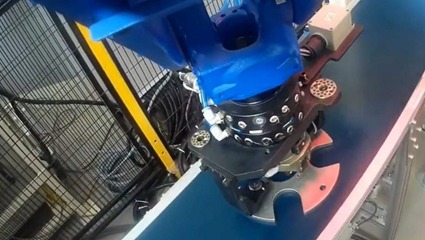Automation is the foundation of modern industry. The Global Industrial Robotics Market that was valued at $37,875 million in 2016 is poised to reach $70,715 million by 2023, growing at a CAGR of 9.4% from 2017 to 2023. As the manufacturing world shifts towards Industry 4.0, industries actively seek more automation opportunities and technology enhancements.
Robots have excelled in performing repetitive, predefined tasks against rigid, well-defined objects that are placed in the same location. However, if the dimensions of the object or its location are varied, the robots would fail. Tersely, the robot is ‘blind’ without some kind of assistance. So, how do we make these systems more powerful and flexible? This is where vision systems enter the picture. Machine vision is the technology that adds intelligence and allows the robots to ‘see’. This combination called vision-guided robotics has unlocked the doors to automating more complex tasks.
What is Vision Guided Robotics?
Over the past few decades, automation technology has made quite some massive leaps. We now have faster, more accurate and more flexible robots that are capable of performing a wider variety of tasks. In parallel, vision technology has also become cheaper and more intelligent over the years. Needless to say, the union of these two powerful automation technologies has proven instrumental in virtually all kinds of industries. This combination is called Vision Guided Robotics (VGR).
Vision-guided robotics is a collective term for the technologies needed to recognize, process and handle items based on visual data.
 Essentially, a vision-guided robotics system has a camera that takes a picture of an object and analyzes the image to communicate the precise coordinates to a robotic arm. The robotic arm, in turn, reaches the position and performs the desired function.
Essentially, a vision-guided robotics system has a camera that takes a picture of an object and analyzes the image to communicate the precise coordinates to a robotic arm. The robotic arm, in turn, reaches the position and performs the desired function.
Some prominent ways in which VGR adds value to the industrial landscape are:
– Improve net throughput of an assembly lines allowing a quick ROI.
– Reduce production costs and improve product quality.
– Easier to use and more flexible.
– Work 24/7 and still maintain optimum efficiency.
– Handle repeatable tasks with high levels of accuracy.
Automated Pick & Place With VGR
Pick and place robots find widespread use in the modern industrial landscape. These robots handle the repetitive task of picking up parts and placing them at some other specified location. Pick and place robots are typically mounted on a stable stand and carefully positioned so as to reach the different areas to perform their job. These robots can identify, pick and move the items with the aid of vision systems. They can be configured with end-of-arm tooling options to be used in different kinds of applications. Aside from manufacturing, some other applications of pick and place robots are:
Assembly
In assembly applications, pick and place robots grab the incoming parts from a location, such as a conveyor, and then place or affix the part onto another piece of the object. The joined parts are then transported to the next assembly stage.
Inspection
Powered by advanced machine vision systems, pick and place robots can be used to pick an object off the conveyor and place it at some specified location to detect anomalies. The parts found defective can be placed into a designated location.
Packaging
Pick and place robots used in the packaging process can grab incoming items and then place them in a packaging container.
The chief benefits of pick and place robots are speed and consistency. While designs may vary, these robots are usually lightweight and small in size, making them ideal for use in applications where the space is limited. On the other side, automated pick and place robots eliminate operators from the monotonous loop, which boosts production efficiency while alleviating the physical strain on human workers.
How to Choose the Right Machine Vision System?
Picking the apt type of machine vision system depends on various factors, such as compatibility between the vision systems and industrial robots, scalability for handling other product types, the intended use or application, etc.
Industry expert, Qualitas, can interface with numerous industrial robots such as Kuka, Yaskawa, ABB, to name a few, to guide the robotic controller to a location. Also, depending on the resolution requirements, they can customize the imaging hardware according to the application needs. The Qualitas standard EagleEye® Software suite is ideal for the development of applications to perform the required tasks.
For more information: www.qualitastech.com
Tags: 3d vina, hiệu chuẩn, hiệu chuẩn thiết bị, máy đo 2d, máy đo 3d, máy đo cmm, sửa máy đo 2d, sửa máy đo 3d, sửa máy đo cmm, Vision Guided Robotics Performs Intelligent Automation
